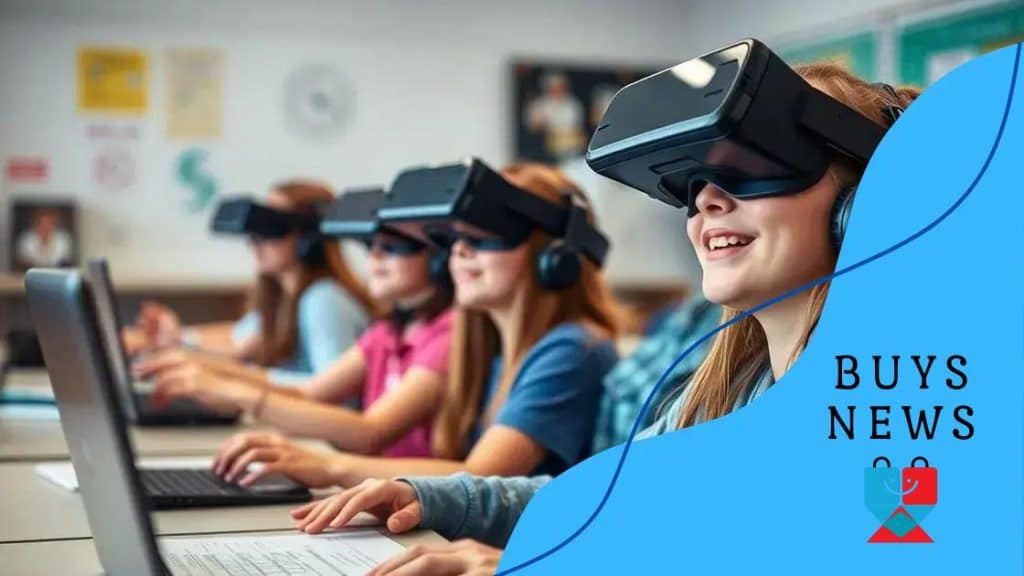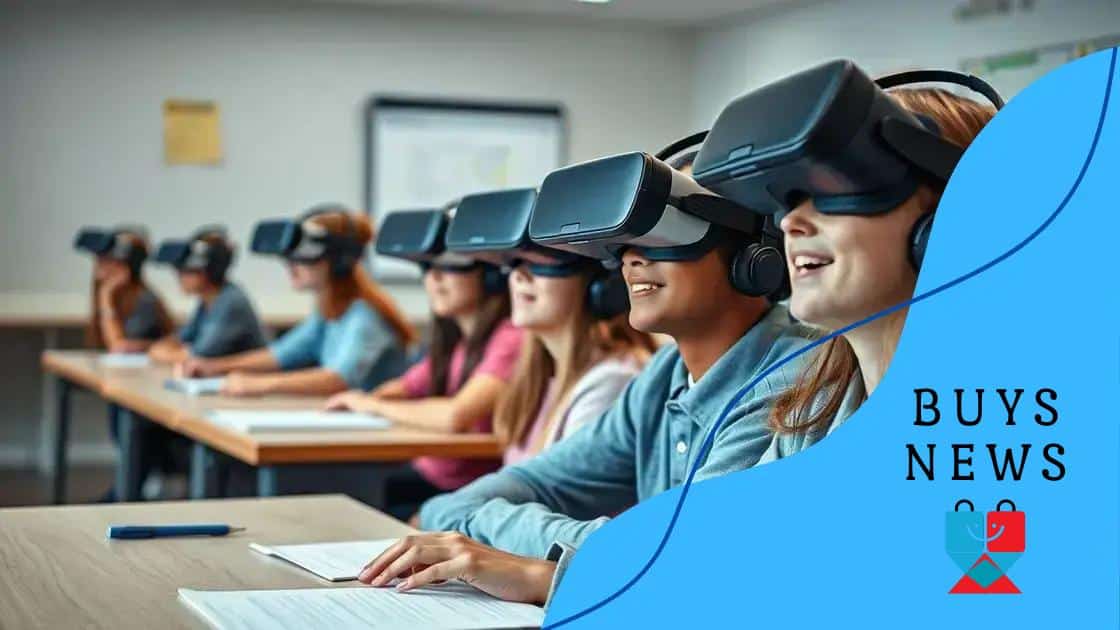Virtual reality in STEM education: a transformative tool

Virtual reality in STEM education enhances learning by providing immersive experiences, increasing engagement, and offering real-life simulations, while also preparing students for future careers through practical skills development.
Virtual reality in STEM education is reshaping how students engage with complex subjects. Imagine stepping into a science lab or exploring the solar system from your classroom! Curious about how this technology can change education? Let’s dive in.
Understanding virtual reality in education
Understanding virtual reality in education can change how students learn. This technology provides immersive experiences, allowing learners to explore intricate subjects in an engaging way.
As educators adapt to new teaching methods, virtual reality stands out as a significant tool. It creates realistic simulations, which can enhance understanding and retention of complex concepts.
What is Virtual Reality?
Virtual reality involves computer-generated environments that simulate real-world or imaginary settings. Students wearing headsets can find themselves in a lab, outer space, or ancient civilizations. This enables them to experience scenarios that are otherwise difficult to access in a traditional classroom.
Benefits of Virtual Reality in Education
- Increases engagement and motivation among students.
- Provides hands-on experiences without physical limits.
- Enhances understanding of complex subjects through visual representation.
- Allows for personalization of learning experiences.
Virtual reality helps bridge the gap for students who may struggle with traditional learning methods. For instance, visual learners benefit from seeing concepts in action, while interactive learners enjoy engaging with the material. By incorporating this technology, educators can support various learning styles.
Furthermore, students can collaborate in virtual reality spaces, enhancing teamwork and communication skills. As they navigate virtual environments together, they develop problem-solving skills essential in real-life situations.
In summary, understanding virtual reality in education reveals its potential to transform learning. By creating captivating and immersive experiences, it not only engages students but also supports their educational growth.
Benefits of virtual reality in STEM learning
The benefits of virtual reality in STEM learning are vast and impactful. By incorporating immersive technology, education can become not just informative but also engaging and memorable.
When students experience lessons through virtual reality, they are more likely to retain the information. This technology allows them to interact with complex concepts in a way that traditional methods cannot match.
Enhancing Engagement
Virtual reality captures students’ attention by creating interactive scenarios. For example, a lesson on biology can take students inside a cell, allowing them to see and understand cellular functions. This approach makes learning fun and thrilling.
Promoting Hands-On Learning
- Students can conduct virtual experiments without the risks involved in a real lab.
- They can manipulate variables and gather instant feedback on their actions.
- This hands-on approach encourages curiosity and exploration.
Additionally, virtual reality breaks geographical barriers, allowing students to explore places and events they might never see in person. Imagine taking a field trip to Mars or witnessing a historical event firsthand—all from the classroom!
Moreover, teachers can tailor experiences to fit different learning styles. Some learners grasp concepts better through visuals, others through interactive simulations. Virtual reality accommodates these diverse needs, ensuring that every student has the chance to thrive.
Fostering Collaboration
This technology cultivates teamwork skills. Students can work together in virtual environments, solving problems collaboratively, which prepares them for future workplaces. As they navigate these immersive settings, they learn to communicate effectively and develop critical thinking skills.
These benefits highlight how virtual reality can revolutionize STEM learning. It transforms challenging subjects into engaging experiences, while also fostering collaboration and curiosity among students.
How to integrate virtual reality in classrooms

Integrating virtual reality in classrooms can transform the learning experience for students. It allows for immersive education that engages learners in innovative ways. However, careful planning and execution are essential for a smooth integration.
To start, teachers should choose the right equipment that fits their classroom needs. There are various VR headsets available, each offering different features. Selecting affordable and user-friendly options will make it easier for both educators and students to adapt.
Setting Up the VR Environment
Creating a designated VR area in the classroom is crucial. This space should be free from distractions and safe for students to move around. Ensure that there is enough physical space for students to interact with the VR content without risk.
- Clear the area of obstacles.
- Ensure good lighting to enhance visibility.
- Provide comfortable seating if necessary.
Once the space is ready, the next step is to select appropriate content that aligns with the curriculum. Many educational platforms offer a range of virtual reality applications tailored for different subjects. For instance, science classes can utilize VR to explore ecosystems or conduct virtual chemical experiments.
Training and Familiarization
Teachers should take the time to familiarize themselves with VR tools and software. Online tutorials and community forums provide valuable resources for troubleshooting and best practices. Engaging in professional development sessions focused on virtual reality can also enhance teaching skills.
Involving students in this process can be beneficial. Allow them to explore VR tools and applications before diving into lessons. This encourages excitement and ownership over their learning experience.
Incorporating Lessons
When integrating virtual reality lessons, consider using them to complement existing curriculum. For example, a history class can utilize VR to virtually visit ancient Rome, providing a deeper understanding of the culture and architecture.
- Plan lessons that build upon traditional teaching methods.
- Encourage group discussions and reflections after VR sessions.
- Utilize assessments to evaluate student understanding.
By integrating virtual reality thoughtfully, educators can create a dynamic environment where students thrive. The use of immersive technology not only enhances engagement but also fosters critical thinking and collaboration skills.
Challenges and considerations for VR in education
While integrating virtual reality in education offers many benefits, there are also significant challenges and considerations to address. Understanding these obstacles can help educators plan effectively and enhance the learning experience.
One major challenge is the cost of VR technology. High-quality headsets and software can be expensive, making it difficult for some schools to implement. Additionally, ongoing maintenance and updates are necessary to keep the technology functional and relevant.
Technical Limitations
Another issue is related to technical skills. Both teachers and students must be comfortable using VR tools. Training is essential, but it can require time and resources that some institutions may lack. As technology continues to evolve, staying up-to-date with the latest advancements can be a significant hurdle.
Content Availability
Finding appropriate educational content for virtual reality is also a concern. While many applications exist, not all are suitable for classroom use. Educators need to evaluate the resources to ensure they meet curriculum standards and learning objectives.
- Assess content quality and relevance before use.
- Collaborate with developers to create custom experiences.
- Encourage student feedback to improve material.
Moreover, accessibility is a critical consideration. Not all students may be able to use VR effectively, due to physical or sensory limitations. Educators must provide alternative options so every student can benefit from immersive learning.
Classroom Management
Managing a classroom while using virtual reality can present its challenges. Teachers may face difficulties in ensuring all students remain focused and engaged during VR sessions. It’s essential to establish clear guidelines and maintain an orderly environment to facilitate effective learning.
In summary, considering these challenges is vital for successful integration. By addressing cost, technical training, content availability, accessibility, and classroom management, educators can create a more effective and inclusive learning environment with virtual reality.
Future implications of VR in STEM fields
The future implications of virtual reality in STEM fields are promising and transformative. As technology continues to advance, VR may reshape how education is delivered and how students engage with complex subjects.
One significant aspect is the potential for widespread adoption in various educational settings. Schools that embrace virtual reality can provide students with immersive experiences that bring theoretical concepts to life. Imagine students exploring the human body in 3D or simulating engineering projects before ever stepping into a real-world environment.
Advancements in Technology
As VR technology becomes more affordable and user-friendly, we can expect larger-scale implementation in classrooms. Enhanced graphics and interactive features will allow for even more engaging educational experiences. This progress may also include developments like mixed reality, where students interact with both digital and physical environments.
Career Preparation
Virtual reality will increasingly play a role in career and technical education. By simulating real-world tasks, students can gain practical skills in a safe environment. Fields such as healthcare, engineering, and computer science will greatly benefit from this hands-on approach. Students can practice procedures, experiment with designs, and develop software—all within a VR setting.
- Increased engagement in STEM subjects.
- Higher retention rates of complex concepts.
- Improved collaborative skills through group projects.
Moreover, the ability to take virtual field trips to places like outer space, the depths of the ocean, or historical landmarks will create unforgettable experiences for learners. Such journeys will not only enhance knowledge but also inspire passions in science and technology.
Global Collaboration
Another implication involves global collaboration. Virtual reality can connect students from different parts of the world in shared learning experiences. This connectivity fosters cultural exchange and understanding, vital skills in our increasingly globalized society.
Furthermore, educators can collaborate on curriculum development, creating global projects that require teamwork across borders. This will prepare students for a multicultural work environment, enhancing their adaptability and communication skills.
In conclusion, the future of virtual reality in STEM fields presents countless opportunities to enhance education, engage students, and prepare them for future careers. As we embrace this technology, we can expect to see a generation of learners who are more equipped to tackle global challenges.
virtual reality in education offers exciting opportunities for both teachers and students. As we look toward the future, it’s clear that VR technology can reshape learning experiences in STEM fields. From engaging lessons to real-life simulations, the benefits are numerous. However, educators must be mindful of the challenges and approaches needed to implement this technology effectively. Overall, the potential of virtual reality to enhance engagement, collaboration, and understanding in education is truly remarkable.
FAQ – Frequently Asked Questions about Virtual Reality in Education
What are the benefits of using virtual reality in classrooms?
Virtual reality increases student engagement, provides hands-on experiences, and allows for immersive learning that enhances understanding of complex concepts.
What challenges do teachers face when integrating VR technology?
Teachers may encounter issues such as the high cost of equipment, the need for technical training, and ensuring content is suitable for educational purposes.
How can virtual reality enhance collaboration among students?
Virtual reality can create interactive environments where students work together on projects, improving their teamwork and communication skills.
What is the future of virtual reality in STEM education?
The future of virtual reality in STEM education includes broader adoption, improved technology, real-life simulations, and increased global collaboration among students.





